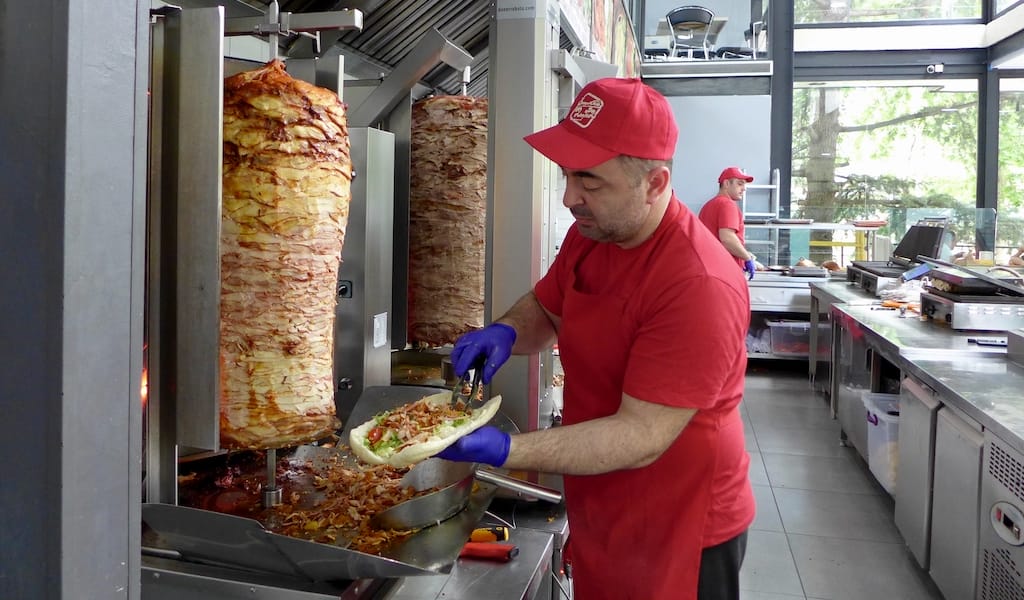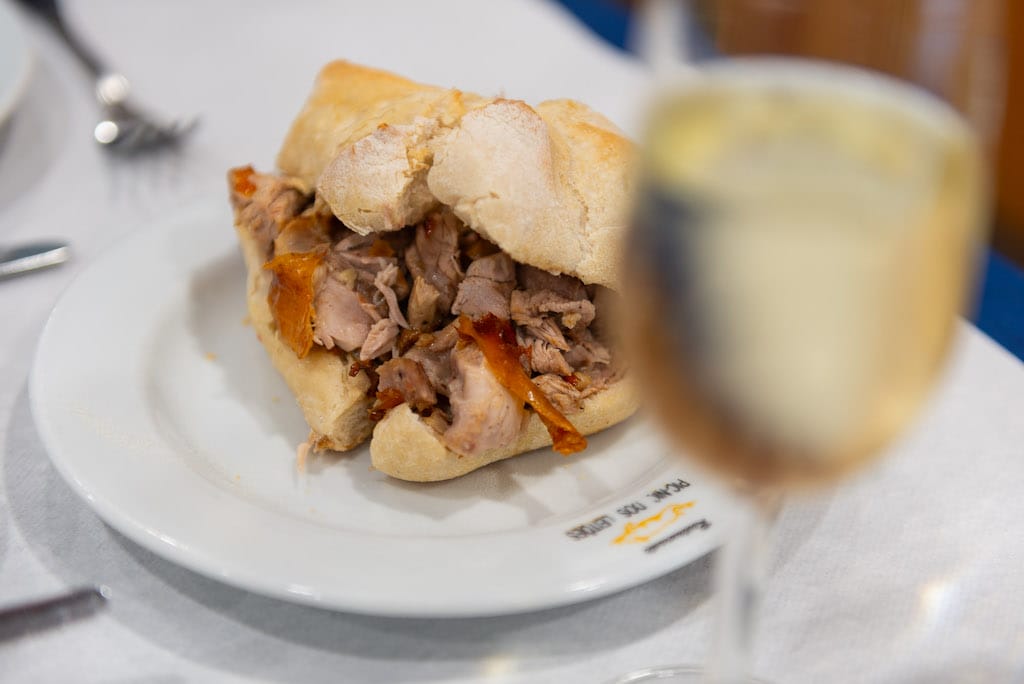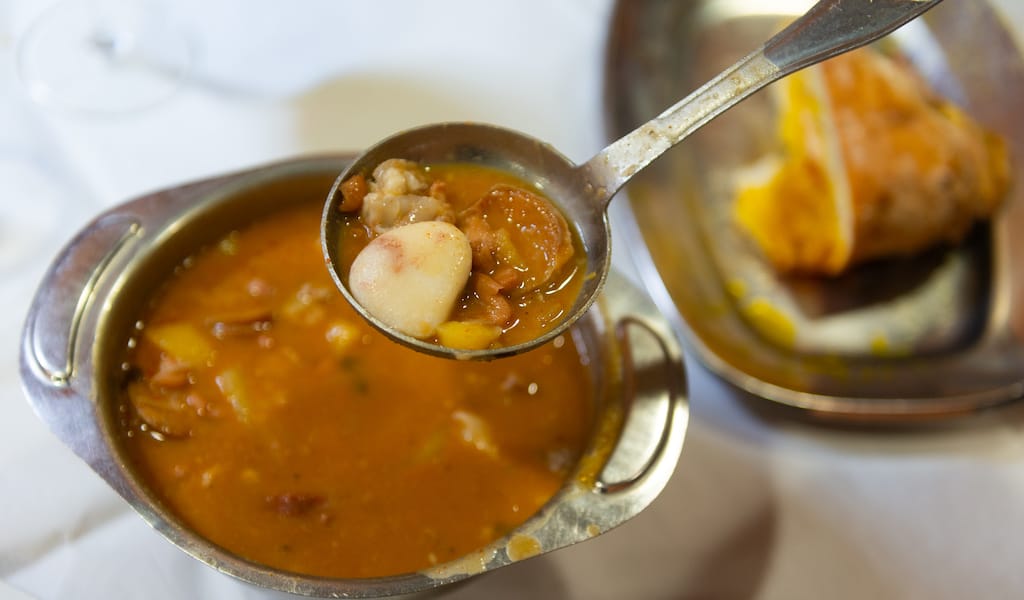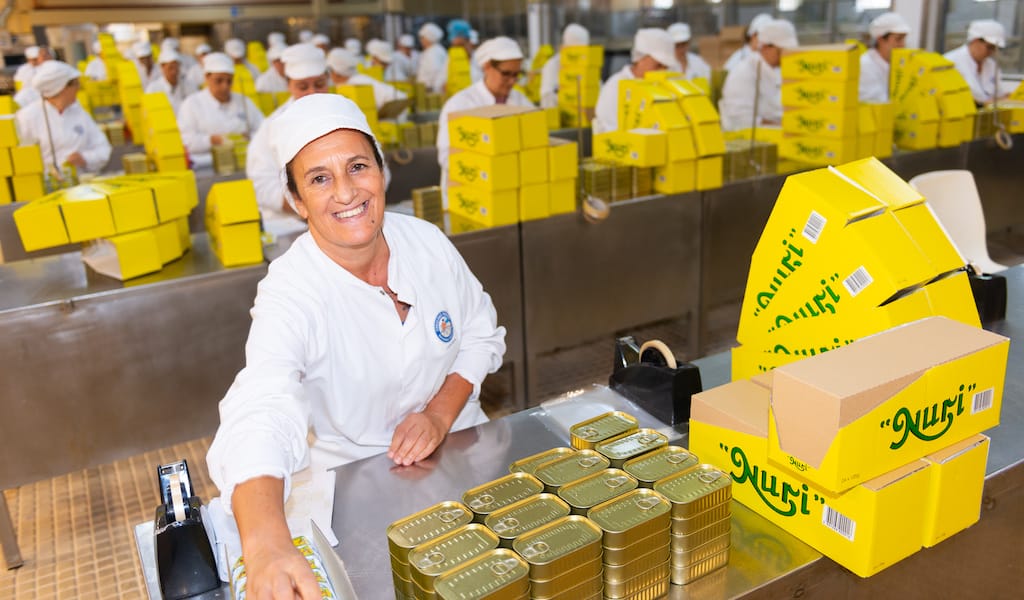Gldani was built on the northern outskirts of Tbilisi during the 1970s and 1980s as a satellite city of well-ordered concrete towers for the working masses. Newer and pricier (though still uninspired) real estate developments are now challenging the Soviet blocks, but Gldani still remains predominantly a working-class district.
Located around the last stop of Tbilisi’s main metro line, Akhmeteli Theatre, Gldani’s center “is packed with local businesses like exchange kiosks, shopping malls, street vendors, casinos or cafes,” writes Tbilisi architecture biennale founder Tinatin Gurgenidze, before adding: “And the famous Gldani Shaurma is also nearby.”
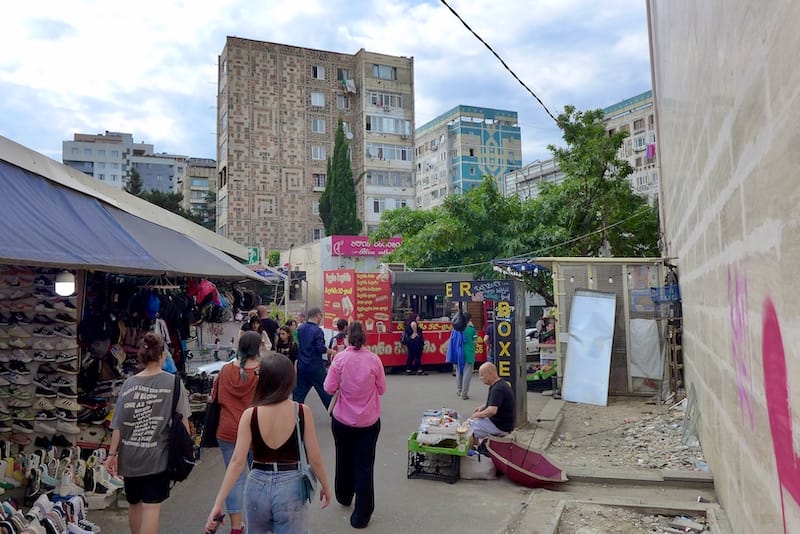
Gldani has long been associated with shuarma, as shawarma – the classic dish of meat sliced off a rotating spit – is often transliterated here. When we walked out of the subway, it took no time to stumble upon the first საშაურმე, or sashaurme, a Georgian word that means “a place where shuarmas are sold.” The food booth sells shaurma sandwiches of different sizes, starting at 5 laris ($1.90 USD) for smaller ones. Prices usually begin at 9 laris ($3.40 USD) in more established sashaurmes that are just a few meters away – in the two streets close to the metro station, there are no less than a dozen of these eateries.
Gldani’s shuarma legacy has become a kind of culinary urban myth around which historical facts are scarce. During the 2020 parliamentary elections, a national TV broadcaster even asked local candidates if they liked “Gldani shaurma” – and all of them felt compelled to give a positive reply. They seemed to know better than to show contempt for this beloved local wrap. Indeed, people from all walks of life, young and old, women and men alike, queue up in Gldani to get their shauarma fix. Some even drive from other districts. To try it first hand, we visited and stopped at a few places, starting where – most likely – the Gldani shaurma success story started.
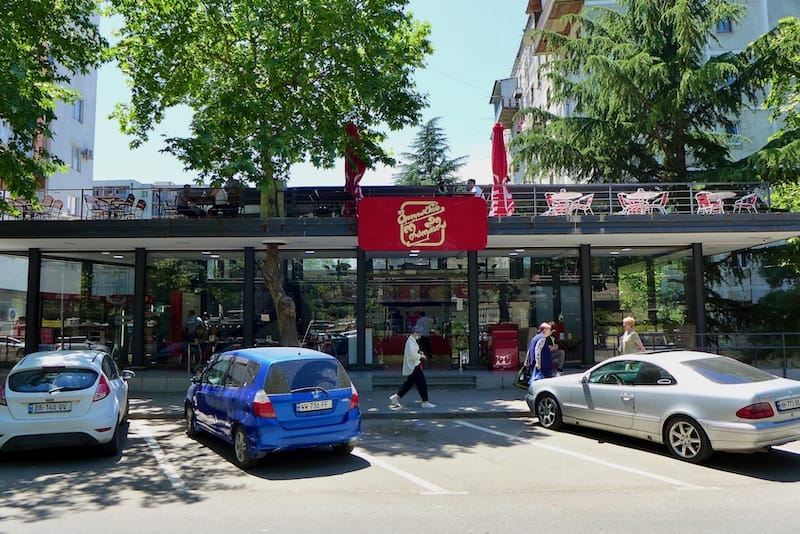
Tbilisi’s pioneering sashaurme is indeed called “Gldani’s Shaurma,” a name that helps to link the district with the dish. It is located in a modern building with a glass facade. “It opened in 2007; first it was on the upper side of the street, then [it moved to] the lower side, and for several years we have been here,” said Tamta Khoriashvili, the restaurant’s director.
Tamta was recently appointed and could not provide too much information to help us in our quest to uncover the origin of the hype around shaurmas in Gldani: “We were not the first shawarma place in Georgia but before us it was less popular,” she said.
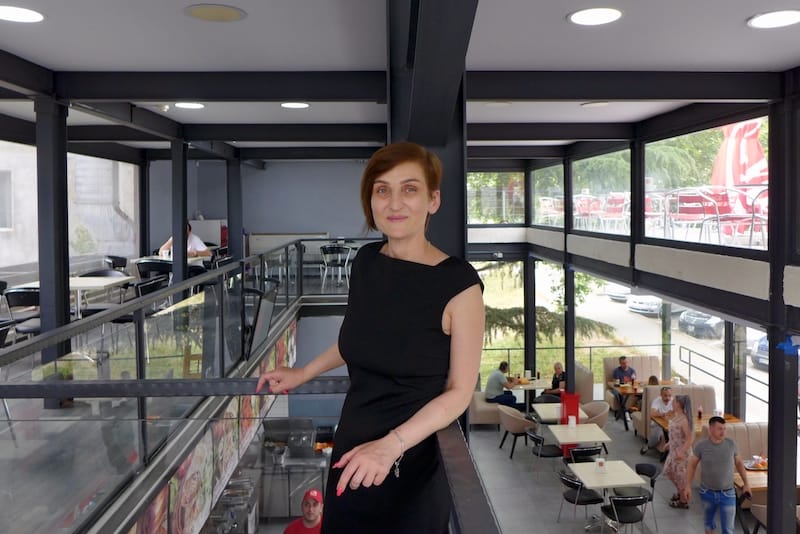
Georgian shaurma is closer to its Turkish counterpart (called döner) than to the Lebanese-Syrian version, which is smaller and wrapped in a thinner flatbread. The main difference between Turkey and Georgia is that pork is the most popular meat here (as opposed to beef or lamb in Turkey)
“The recipe is more or less the same around Georgia, only the [marinade] differs,” added Tamta. Behind Gldani Shaurma’s long counter, two big stacks of meat are roasting on a spit: one for pork and one for chicken. Before cutting and adding the meat, cooks place an assortment of standard ingredients atop lavash flatbread: lettuce, tomatoes, onions and small green chili peppers. Then, two condiments are usually added: ketchup and mayonnaise.

At Gldani Shaurma, customers can also pick an alternative wrap served with a barbecue sauce. We went for the restaurant’s signature dish, called the “royal shaurma.” It is served on a plate with chicken from the spit or a mix of chicken and pork. Chopped onions, lettuce, French fries and a few pickles are added. The two sauces are different from the standard shaurmas; one is made with tomato paste and walnuts and the other is a mayonnaise that includes a secret ingredient. (Tamta did not reveal what it was and we couldn’t guess, but we appreciated the balance of tastes, which paired perfectly with the roasted meat.)
We continue along Gldani’s main shaurma street, named after the Georgian Soviet actor and director Akaki Vasadze. A few doors down, we found another place that sells a slightly more Georgianized version of the shaurma. It’s easy to spot Balu Shaurma, which sports a big image of The Jungle Book’s famous bear on its wall. “We don’t have a specific recipe, but the pork meat is first grilled on a barbecue and then cut in small pieces,” said Balu Shaurma’s manager Nino, who has been working at Balu since it opened eight years ago.
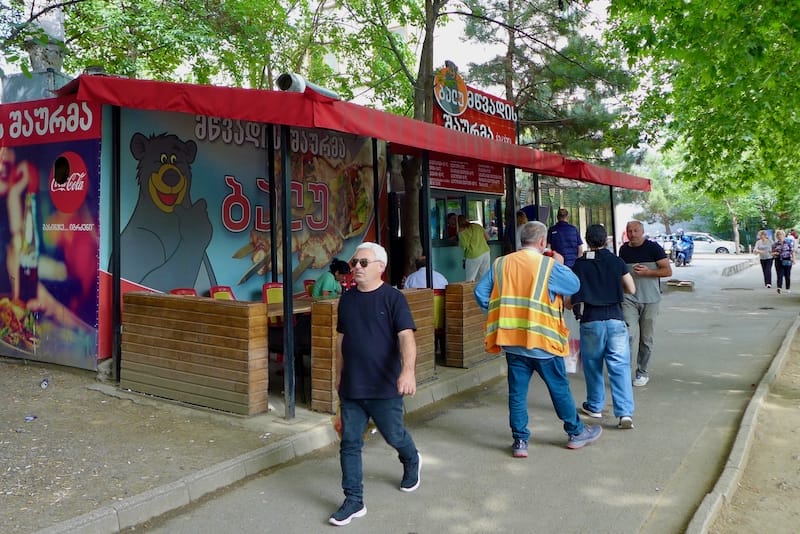
Grilled pork and chicken are on the menu of every traditional Georgian restaurant, but it’s not particularly common to see shuarma meat prepared on a horizontal grill. While we waited for our shaurma, we observed an employee fanning the embers of the grill with a hair dryer. We sat down in the backyard terrace to indulge in our wrap. We did not find a big difference in taste, but the barbecued pork might sit less heavy on the stomach. “Barbecue meat is more ecological,” opined Nino.
We pondered the carbon footprint of the two ways of grilling meat as we headed towards our last stop: Hungryman, the newcomer on Gldani’s sashaurme scene, located on the other side of the metro station.
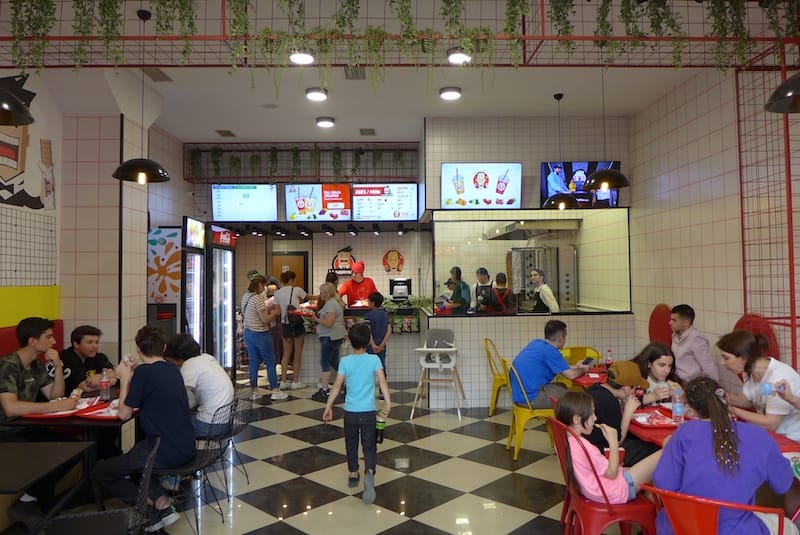
The interior design is slick, the walls covered with square white tile, leafy plants dangling from a red wire structure and shaurmas prepared behind a glass window. “We opened last January,” said Dato Anakidze, only 21, who works as the main chef and previously won his spurs at Gldani Shaurma.
Three local friends opened the Hungryman fast food restaurant after the success of their YouTube channel of the same name. The entertainment and humor channel began four years ago primarily as a food channel and then started to diversify to include other manly hobbies such as cars, card games, drinks, smartphones and sport. The first episode was dedicated to shaurmas. The friends appeared blindfolded and tasted shaurmas from five different places. Ok Shaurma (not in Gldani) was given the best grades, ahead of Gldani Shaurma and Mac Shaurma, a chain that successfully copied the branding and interior design associated with the global burger company.
 “I like my shaurma with less ketchup and mayo but more chili peppers,” said Dato before going back to the kitchen. Hungryman follows the standard recipe but innovations are on the way, promised Dato, as the company is refining its homemade sauce and will soon offer other fast food options, such as Mexican hot dogs. We ordered our last shaurma of the day. It was well-seasoned and the meat was soft, and we also enjoyed the small bottle of cherry compote. In addition to the usual sodas, Hungryman sells its own brand of compote, or kompoti in Georgian, a fruit-based drink popular in the Caucasus region.
“I like my shaurma with less ketchup and mayo but more chili peppers,” said Dato before going back to the kitchen. Hungryman follows the standard recipe but innovations are on the way, promised Dato, as the company is refining its homemade sauce and will soon offer other fast food options, such as Mexican hot dogs. We ordered our last shaurma of the day. It was well-seasoned and the meat was soft, and we also enjoyed the small bottle of cherry compote. In addition to the usual sodas, Hungryman sells its own brand of compote, or kompoti in Georgian, a fruit-based drink popular in the Caucasus region.
Business seemed to be going well; the place was packed with customers and couriers stopped in frequently to pick up orders. Although new in the shaurma game, Hungryman aims high: “We will open a second venue in a few weeks in Varketili and then we are thinking about going to Saburtalo and also the cities of Batumi and Kutaisi,” said Dato.
Located on the other end of the metro line and the city, Varketili is a serious competitor to Gldani regarding the number of sashaurmes per inhabitant. Saburtalo also has a few historical shaurma places catering mainly for the students of the nearby medical university. We’ll have to try out these two other shaurma destinations in the future, but for the time being, we settle in on the metro and head back home for a well-deserved digestive nap.
Clément GirardotClément Girardot
Published on June 30, 2023
Related stories
February 7, 2024
PortoAt first glance, there’s not much to see in Mealhada, a town in Portugal’s central inland Bairrada region about an hour’s drive south of Porto. If there is a main feature here, it’s probably the EN1, the country’s original north-south highway, which slices the town in half, providing a conduit for a seemingly never-ending parade…
January 19, 2024
LisbonIt’s an early example of guilt tripping. The story goes that a monk arrived in a Portuguese village, hungry and clever. He grabbed a rock and carried it door to door, claiming that it was his only ingredient, asking people if they would be kind enough to supplement it so he could make a meal.…
December 7, 2023
PortoMatosinhos, it could be said, has seen better times. In its heyday, the semi-industrial-feeling port city just north of Porto was once home to 54 fish canneries. Today, only two remain. Along the city’s wide, empty-feeling streets, some of the city’s former factories and their graceful Art Nouveau facades have been reappropriated as other businesses…







































